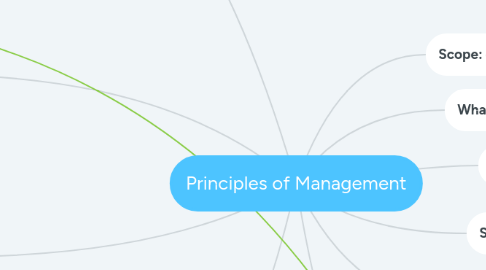
1. Planning
1.1. Why do we need planning?
1.2. Types of plans (S2 s7)
1.2.1. Strategic
1.2.2. operational
1.3. Org Goals Setting
1.3.1. Vision/mission/goals/obj
1.3.2. Traditonal goal setting
1.3.3. MBO
1.3.3.1. 8 Steps
1.4. Strategic plan
1.5. Operational plan
1.6. Strategic management process
1.7. +SWOT
1.8. Types of Org Strategies
1.8.1. Corporate strategies
1.8.1.1. Growth
1.8.1.2. Renewal
1.8.1.2.1. Retrenchment
1.8.1.2.2. Turnaround
1.8.1.3. Stability
1.8.2. Competitive Strategies
1.8.2.1. Cost-leadership
1.8.2.2. differentiation
1.8.2.3. focus
1.8.3. Functional strategies
2. Organizing
2.1. 6 key elements
2.1.1. work specialization
2.1.2. departmentalization
2.1.3. chain of command
2.1.4. span of control
2.1.5. formalisation
2.1.6. centralisation
2.2. contingency factors
2.2.1. overall strategy
2.2.2. size
2.2.3. technology
2.2.4. degree of environmental uncertainly
2.3. Organiszation design model
2.3.1. traditional model
2.3.1.1. simple structure
2.3.1.2. functional
2.3.1.3. divisional
2.3.2. contempoary model
3. Leading
3.1. communication theory
3.1.1. types of communication
3.1.2. functions of communtion
3.1.3. commuincation process
3.1.4. evaluating commuincation methods
3.1.5. effective communication
3.1.6. communication network
3.2. Leadership theories
3.2.1. Stage 1
3.2.1.1. Trait theories of leadership
3.2.2. stage 2
3.2.2.1. behavioral theories of leadership
3.2.2.1.1. University of Iowa
3.2.2.1.2. The Ohio State
3.2.2.1.3. University of Michigan
3.2.2.1.4. managerial grid
3.2.3. stage 3
3.2.3.1. contingency theory
3.2.3.1.1. fiedler model
3.2.3.1.2. situational leadership
3.2.3.1.3. path-goal theory
3.2.4. stage 4
3.2.4.1. contemporary view
3.2.4.1.1. charismatic
3.2.4.1.2. visionary
3.2.4.1.3. transactional/transformational
3.3. challenge of leadership
3.4. trust
3.5. motivation
3.5.1. early theories
3.5.1.1. 2 factors theory
3.5.1.2. theory X Y
3.5.1.3. 3 needs theory
3.5.1.4. hierarchy
3.5.2. contemporary theories
3.5.2.1. goal-setting
3.5.2.2. job charactisiticxss
3.5.2.3. equity
3.5.2.4. expectan y
4. Controlling
5. Scope: organization (S1 s4)
5.1. Goals / structure / People
6. What is Management (S1 s8)
6.1. Efficiency
6.2. effectiveness
6.3. goals
6.4. people
7. Managerial Roles
7.1. Interpersonal
7.1.1. Figurehead
7.1.2. Leader
7.1.3. Liaison
7.2. Decisional
7.2.1. Entrepreneur
7.2.2. Disturbance hander
7.2.3. Resource allocator
7.2.4. Negotiator
7.3. Informational
7.3.1. Monitor
7.3.2. Disseminator
7.3.3. Spokeperson
8. Skills
8.1. General
8.2. Specific
9. stakeholder mgmt
9.1. Who?
9.2. How?
9.2.1. 1. identifity stakeholders (power/influence/interest)
9.2.2. 2. prioritize them
9.2.3. 3. understand them
9.2.4. 4. develop a map
9.2.5. 5. develop a plan
9.3. Principles of stakeholder mgmt
10. CRM
10.1. CRM process
10.1.1. acquire
10.1.2. enhance
10.1.3. retain
10.2. relationship marketing
10.2.1. 3 levels of relationship marketing
